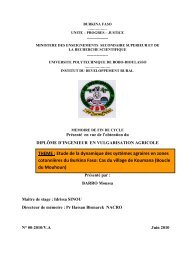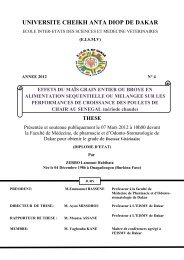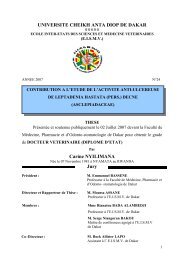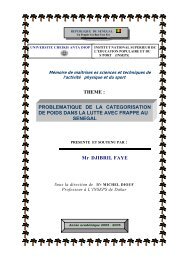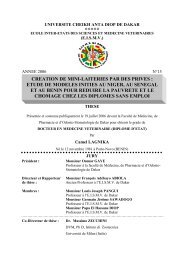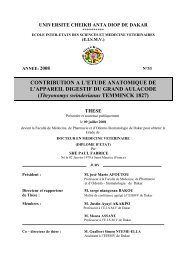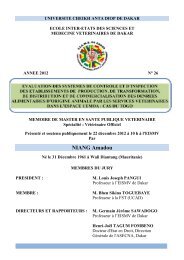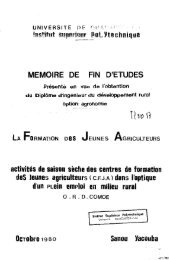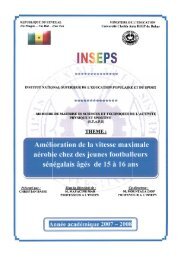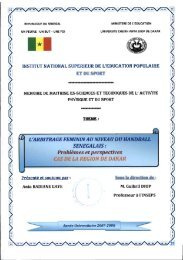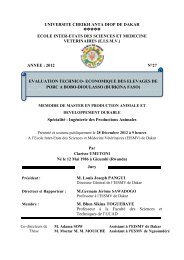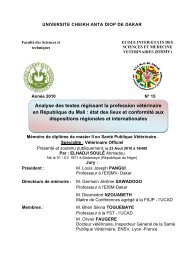escherichia coli - BEEP
escherichia coli - BEEP
escherichia coli - BEEP
Create successful ePaper yourself
Turn your PDF publications into a flip-book with our unique Google optimized e-Paper software.
« Surveillance de la résistance aux antibiotiques des souches de<br />
Salmonella spp et d’Echerichia <strong>coli</strong> isolées de la viande de poulets<br />
de chair au Sénégal »<br />
DIOUF Khar Coumba Ndoffène<br />
Mémoire de DEA de Productions Animales<br />
RESUME<br />
La propagation des bactéries pathogènes résistantes aux<br />
antibiotiques est une des menaces les plus sérieuses pour un<br />
traitement efficace d’une maladie. Contrairement aux pays<br />
développés, en Afrique en général et au Sénégal en particulier peu<br />
de données sont disponibles sur l’antibiorésistance surtout des<br />
souches vétérinaires. C’est pour contribuer à combler cette lacune<br />
que nous avions entrepris la présente étude sur l’évolution de<br />
l’antibiorésistance des souches de Salmonella spp et d’Echerichia<br />
<strong>coli</strong>, une année plus tard après l’étude de FOFANA (2004).<br />
Au total, 100 carcasses de poulets de chair dont 50 carcasses<br />
dans 20 élevages et les 50 autres dans 19 points de vente ont été<br />
prélevées dans la région de Dakar. Les échantillons ont été<br />
prélevés de décembre 2004 à juin 2005 et d’août à octobre 2005<br />
correspondant à l’hivernage.<br />
Les analyses microbiologiques de ces carcasses nous ont permis<br />
d’isoler 71 souches de Salmonella spp et 85 souches<br />
d’Escherichia <strong>coli</strong>. 85% (17) des élevages et 52,63% (10) des<br />
points de vente visités sont positifs aux salmonelles. Sur les 20<br />
sérovars identifiés, les plus prévalents sont Hadar (16), Kentucky<br />
(8), Chester (7), Schwarzengrund (7) et Llandoff (6).<br />
L’étude de la sensibilité vis-à-vis des 16 antibiotiques choisis ont<br />
montré que 85,91% des souches de salmonelles se sont révélées<br />
résistantes à un antibiotique ou plus. La résistance quintuple est la<br />
plus fréquente avec 29,75% des souches (l’ampicilline,<br />
tétracyclines, triméthoprime, sulfamides et l’association<br />
triméthoprime- sulfamétoxazole). En outre, une souche de<br />
Salmonella Typhimurium pentarésistante a été isolée. L’isolement<br />
d’une telle souche dans les carcasses de poulets de chair est l’un<br />
des premiers au Sénégal.<br />
Par ailleurs, 100% des souches d’E. <strong>coli</strong> se sont révélées<br />
résistantes au moins à un antibiotique et 97,64% de ces souches<br />
ont présenté une résistance multiple à plus de deux antibiotiques.<br />
La résistance à plus de 7 antibiotiques est la plus fréquente et<br />
concerne l’ampicilline, la streptomycine, les sulfamides, les<br />
tétracyclines, le triméthoprime, le triméthoprime-sulfamétoxazole<br />
et l’acide nalidixique.<br />
La comparaison des niveaux de résistance a montré que les<br />
souches d’E. <strong>coli</strong> sont plus résistantes que les souches de<br />
Salmonella spp.<br />
Par rapport à l’étude de FOFANA, l'évolution vers la résistance<br />
connaît une légère augmentation avec les sulfamides, les<br />
tétracyclines, le triméthoprime, le triméthoprime-sulfamétoxazole,<br />
les furanes, la néomycine et la céfoxitine. Néanmoins, la tendance<br />
est à la baisse avec l'ampicilline, la <strong>coli</strong>stine, la ciprofloxacine et<br />
la fluméquine.<br />
Il reste à présent de comparer la méthode de diffusion à la<br />
méthode dilution pour déterminer la concentration minimale<br />
inhibitrice (CMI) de certains antibiotiques d'intérêt stratégique et<br />
caractériser génétiquement les souches multirésistantes, et ce, à<br />
l’image de ce qui se fait chez l’homme.<br />
Mots-clés : Salmonella spp – Escherichia <strong>coli</strong> - poulet de chair –<br />
antibiorésistance - Sénégal<br />
“Surveillance of the resistance to antibiotics of the strains of<br />
Salmonella spp and Escherichia <strong>coli</strong> from avian origin in<br />
Senegal”<br />
DIOUF Khar Coumba Ndoffène<br />
“DEA” (or Master) of Animal Productions<br />
SUMMARY<br />
The propagation of pathogenic bacteria resistant to<br />
antibiotics is one of the most serious threats to an effective<br />
treatment of diseases. Contrary to developed countries, in<br />
Africa and in particular Senegal, few data are available on<br />
microbial resistance especially those of veterinary interest.<br />
This study on the evolution of antimicrobial resistance of<br />
strains of Salmonella spp and Escherichia <strong>coli</strong> is aimed at<br />
filling this gap.<br />
A total, 100 chicken carcasses 50 of which came from 20<br />
poultry farms and the rest from 19 sale points were taken in<br />
Dakar. These samples were collected during the period from<br />
December 2004 to June 2005 and from August to October<br />
2005 corresponding to the raining season in Dakar.<br />
The microbiological analysis of these carcasses enabled us<br />
to isolate 71 strains of Salmonella spp and 85 strains of<br />
Escherichia <strong>coli</strong>. 85% (17) from the poultry farms and<br />
52,63% (10) from the sale points visited were positive for<br />
the salmonellas. Of the 20 serovars identified, the most<br />
prevalents were Hadar (16), Kentucky (8), Chester (7),<br />
Schwarzengrund (7), and Llandoff (6). The study of the<br />
sensitivity with respect to 16 antibiotics chosen showed<br />
85,91% of Salmonellas strains were resistant to one or more<br />
antibiotics. Resistance to five (5) antibiotics is most frequent<br />
with 29,75% of the strains (ampicillin, tetracycline,<br />
trimetoprim, sulfonamides, and association trimethoprimsulfametoxazole).<br />
Moreover, a strain of Salmonella<br />
Typhimurium pentaresistant was isolated. The isolation of<br />
such a strain in chicken carcasses is one of the first in<br />
Senegal. In addition, 100% of the of the strains of E.<strong>coli</strong><br />
appeared resistant to at least one antibiotic and 97,64% of<br />
this strains had multiple resistance to more than two<br />
antibiotics. Resistance to more than seven (7) antibiotics is<br />
most frequent and related to the ampicillin, the<br />
streptomycin, the sulfonamides, tetracyclines, the<br />
trimethoprim, the trimetoprim-sulfametoxazole and the<br />
nalidixic acid. The comparaison of the levels of resistance<br />
showed that the strains of E. <strong>coli</strong> are more resistant than the<br />
strains of Samonella spp. Compared to FOFANA study<br />
(2004), the evolution towards resistance shows a light<br />
increase with sulfonamides, the tetracyclines, the<br />
trimethoprim, the trimethoprim-sulfametoxazole, furan, the<br />
neomycin and the cefoxitin. Nevertheless, the tendency is<br />
the fall with ampicillin, the <strong>coli</strong>stin, the ciprofloxacin and<br />
the flumequin. It now remains to compare the method of<br />
diffusion with the method dilution to determine the<br />
inhibiting minimal concentration (CMI) of certain<br />
antibiotics of strategic interest and define to characterize<br />
genetically strains with multiple resistance as it is done in<br />
the man.<br />
Key words: Salmonella spp - Escherichia <strong>coli</strong> – chicken -<br />
resistance to antibiotics-Senegal<br />
Adresse : Tel 589 16 65<br />
E-mail : khardiouf2001@yahoo.fr<br />
Adress : Tel 589 16 65<br />
E-mail : khardiouf2001@yahoo.fr<br />
33



